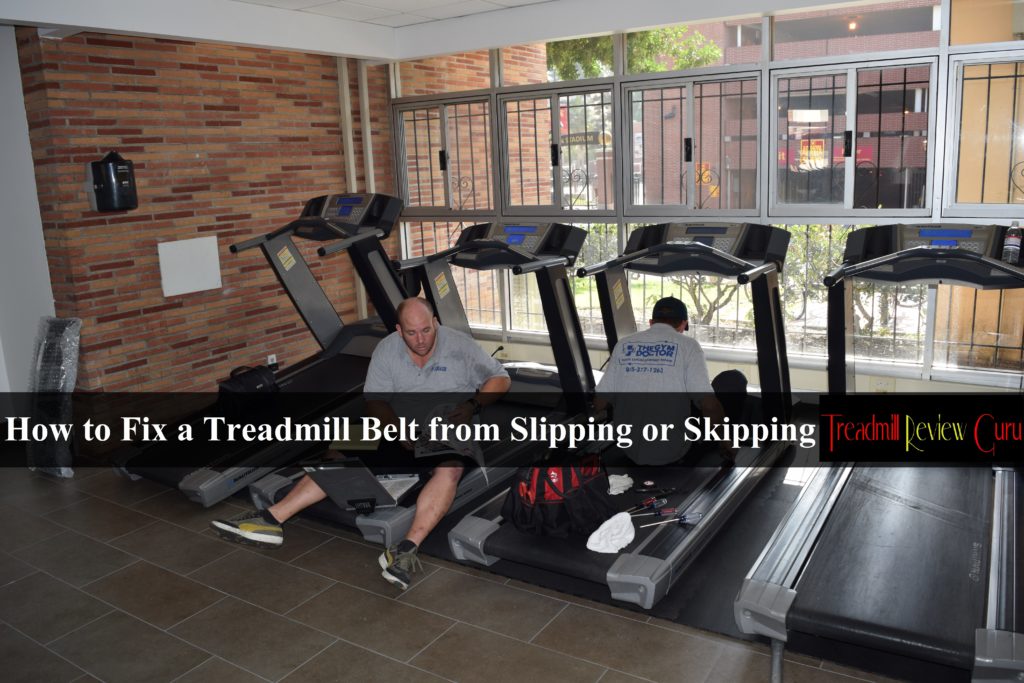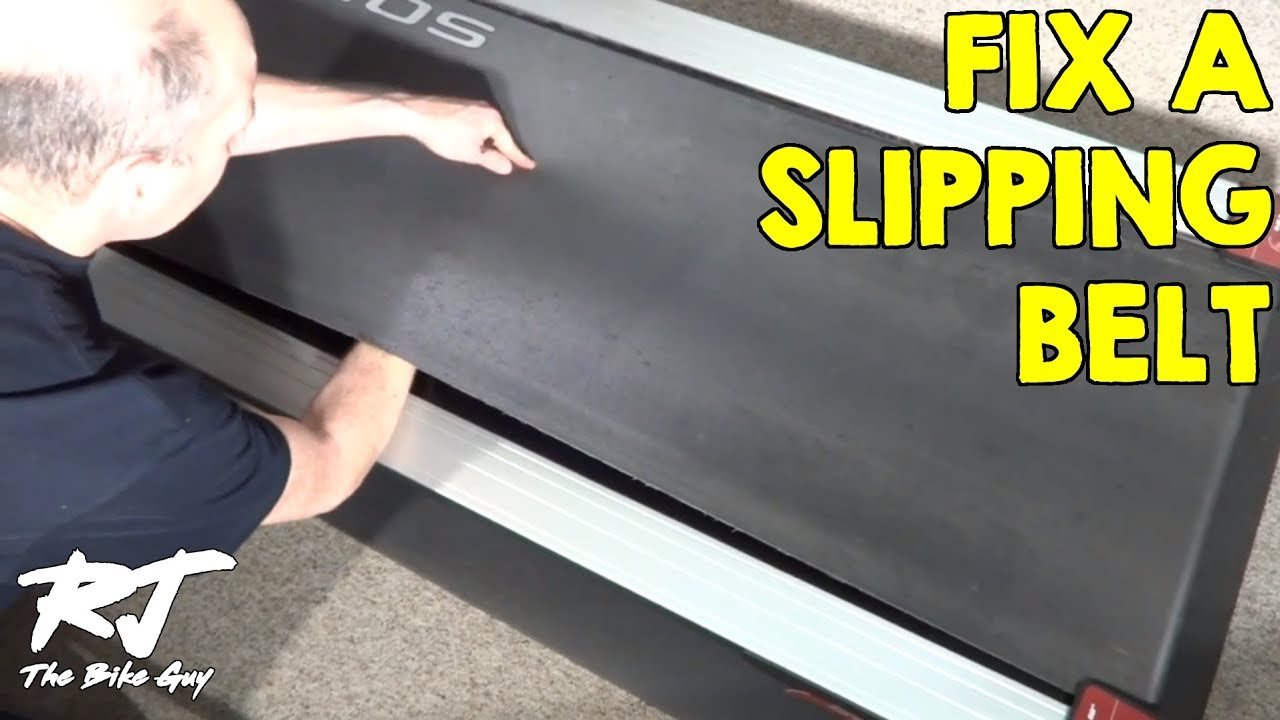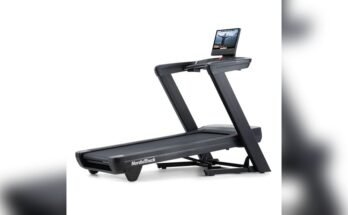To fix a slipping treadmill belt, first verify belt tension and alignment, then adjust as necessary. Lubrication might also resolve the issue.
Treadmill maintenance is key to ensuring your fitness routine remains uninterrupted. A common hiccup encountered by treadmill users is a slipping belt, which can be alarming and potentially dangerous. Addressing this promptly restores the machine’s performance and extends its lifespan.
It’s crucial for users to recognize the signs of a belt problem early on. With straightforward adjustments and routine check-ups, you can often avoid costly repairs or replacements. Troubleshooting a slipping belt involves checking tension, aligning the belt, and applying lubricant if needed. Each of these steps is vital in maintaining the safety and effectiveness of your workout equipment. Remember, regular attention and care will keep your treadmill running smoothly, ensuring your exercise regimen stays on track.

Credit: www.treadmillreviewguru.com
Identifying Treadmill Belt Slippage
Understanding when a treadmill belt is slipping is essential for maintaining your exercise routine without interruptions. It’s important to recognize the signs early. Doing so can save you from potential injuries or further equipment damage.
Symptoms Of A Slipping Belt
Several clear symptoms signal a slipping treadmill belt. Recognizing these will help you act swiftly:
- Jerky movements when starting the treadmill or changing speeds
- Inconsistent belt speed despite steady pace settings
- A sensation of losing traction while walking or running
- Motor noise changes without adjustment to the controls
- The belt may drift to one side, causing uneven wear
Potential Risks Of Ignoring The Issue
Neglecting treadmill belt slippage can pose several risks:
| Consequence | Description |
|---|---|
| Injury | Unexpected slippage could lead to falls or strains. |
| Wear and Tear | Continuous slipping can damage the belt and deck. |
| Motor Stress | An unstable belt increases motor workload and may lead to failure. |
| Increased Costs | Repairs from prolonged issues are often more expensive. |
Address belt slippage immediately to maintain safety and equipment longevity.
Initial Troubleshooting Steps
Encountering a slipping treadmill belt can be frustrating. Before you call a professional, some simple DIY troubleshooting steps could save both time and money. Understanding the root cause is essential, and most often, it’s a matter of belt misalignment or tension issues. Let’s get started with some basic checks.
Checking For Belt Misalignment
Belt misalignment can lead to slipping. Check the alignment with these steps:
- Turn off and unplug the treadmill.
- Stand behind the treadmill and inspect the belt. It should be centered.
- If the belt is off-center, refer to the manual. It will guide on adjustment screws.
- Turn the screws slightly, around a quarter turn.
- Plug in and turn on the treadmill. Observe the belt’s movement.
- Repeat adjustments until the belt centers.
Assessing Belt Tension
Incorrect belt tension is another common culprit for slipping. Assess and adjust the tension as follows:
- Lift the belt’s middle on the side of the treadmill; the gap should be 2 to 3 inches.
- If it’s too loose or tight, locate the tension bolt at the treadmill’s rear end.
- Adjust the bolt; right for tightening, left for loosening.
- Make small adjustments of a quarter turn.
- Check the tension again and continue adjusting as needed.
Simple Fixes You Can Do At Home
Strolling out to your home treadmill for a workout only to discover the belt is slipping can be frustrating. Fortunately, a few simple fixes right in the comfort of your own home can get you back up and running in no time.
Let’s dive into some DIY solutions to ensure smooth and safe treadmill runs.
Adjusting Belt Tension
A loose treadmill belt often causes slipping. Adjusting the tension is a quick fix. Here’s what to do:
- Turn off and unplug your treadmill.
- Locate the tension bolts at the end of the treadmill.
- Use an Allen wrench to turn both bolts clockwise.
- Make quarter-turn adjustments to maintain equal tension.
- Test the belt and repeat if necessary.
Aligning The Belt
If the belt has shifted to one side, it needs realignment. Follow these steps to align:
- Locate the tracking adjustment bolts at the rear.
- Identify the direction of the misalignment.
- Adjust the bolt on the opposite side where the belt has shifted.
- Turn the bolt just a quarter-turn.
- Turn on the treadmill to check the belt’s position.
Lubricating The Belt
Friction between the belt and deck can cause slipping. A well-lubricated belt reduces friction. Here’s how to lubricate properly:
- Check your manual for recommended lubricant type.
- Lift the belt slightly and apply lubricant.
- Spread the lubricant by walking on the belt.
With these simple at-home fixes, your treadmill belt should be in top condition. Belt slipping should no longer disrupt your workout routine!

Credit: www.amazon.com
Preventive Maintenance Tips
Preventive maintenance tips can keep your treadmill in peak condition. A slipping belt disrupts workouts. Regular care prevents this issue. Follow these straightforward tips to ensure a smooth, safe running experience.
Regular Cleaning
Keeping your treadmill clean is crucial. Dirt and debris affect the belt’s grip. Use these steps for regular cleaning:
- Turn off and unplug the treadmill.
- Wipe down the belt with a damp cloth.
- Clean visible dust from the deck and motor area.
- Allow the belt to dry completely before use.
Scheduled Lubrication
A well-lubricated treadmill belt reduces slippage. Lubricate every three months or after 130 miles of use:
- Turn off and unplug your machine.
- Lift the belt and apply lubricant as directed.
- Run the treadmill at a slow speed to spread the lubricant evenly.
Proper Usage Habits
Correct use extends your treadmill’s life and performance. Follow these usage habits:
- Respect weight limits specified by the manufacturer.
- Avoid abrupt starts and stops that strain the belt.
- Ensure proper footwear to maintain belt integrity.
When To Seek Professional Help
Slipping treadmill belts disrupt workouts and pose safety hazards. Identifying when professional assistance is needed helps prevent injuries and further equipment damage.
Persistent Slippage
Recurrent belt slippage despite adjustments entails expert evaluation. Trained technicians scrutinize underlying issues not evident to the untrained eye. Multiple slip incidents signal for help.
Signs Of Wear And Tear
- Visible belt fraying suggests worn-out material.
- Uneven belt wear implies misalignment or imbalanced use.
- Excessive noise indicates potential deck or belt deterioration.
Distinct wear and tear markers warrant immediate professional attention to prevent injury and costly repairs.
Electrical Malfunctions
Anomalies in treadmill operation often point to electrical faults.
| Issue | Action Needed |
|---|---|
| Inconsistent Speeds | Check for electrical inconsistencies |
| Console Errors | Diagnose for electronic malfunctions |
| Motor Overheating | Inspect for wiring or motor issues |
Advise a professional to address complex electrical troubles for safety and functionality.
Choosing The Right Treadmill
If your treadmill belt keeps slipping, it might be time to think about the quality of your equipment. A dependable treadmill can make all the difference in your workout routine. Let’s explore what makes for a great buy.
Factors To Consider
- Motor Power: Stronger motors ensure smoother belt movement.
- Size and Design: It must fit your space and support your stride.
- Belt Quality: A durable belt prevents frequent slips.
- Speed and Incline Options: More settings allow for varied workouts.
- Shock Absorption: Good cushioning protects your joints.
Importance Of Warranty And Support
A solid warranty shields you from hefty repair costs. Prompt customer support aids with quick fixes, like a slipping belt.
| Warranty Length | Coverage Items | Support Features |
|---|---|---|
| 1-5 Years | Motor, Frame, Parts | 24/7 Help, Live Chat |
| Lifetime | Motor, Frame | Email Support, Guides |

Credit: m.youtube.com
Frequently Asked Questions For What To Do If Treadmill Belt Is Slipping
How Do You Fix A Slipping Belt On A Treadmill?
Turn off and unplug the treadmill. Locate the belt adjustment bolts. Use an Allen wrench to turn the bolts clockwise. Tighten each side equally, a quarter-turn at a time. Plug in and test the treadmill, repeating adjustment if necessary.
How Do I Stop My Belt From Slipping?
To stop your belt from slipping, first tighten it to the manufacturer’s specifications. Ensure the pulleys are aligned and free from debris. Regularly inspect for wear and replace belts as necessary. Apply a non-slip dressing if the belt and pulleys are compatible.
Keep the belt tension balanced.
How Do I Get My Treadmill Belt Back On Track?
Turn off and unplug your treadmill. Then, loosen the rear roller bolts with an Allen wrench. Carefully shift the belt back to the center. Retighten the bolts, ensuring the belt is properly aligned. Test by slowly turning on the treadmill.
Why Does My Treadmill Belt Keep Moving To The Side?
A treadmill belt may shift to the side due to uneven tension, misaligned rollers, or an unbalanced walking platform. Regular maintenance and proper alignment can prevent this issue.
Conclusion
Experiencing a slipping treadmill belt can be frustrating, but it’s solvable with the right steps. Regular maintenance ensures your workouts stay on track. For persistent issues, professional help is advisable. Keep your fitness journey moving smoothly by addressing treadmill concerns promptly.
Stay safe and enjoy a steady run!



